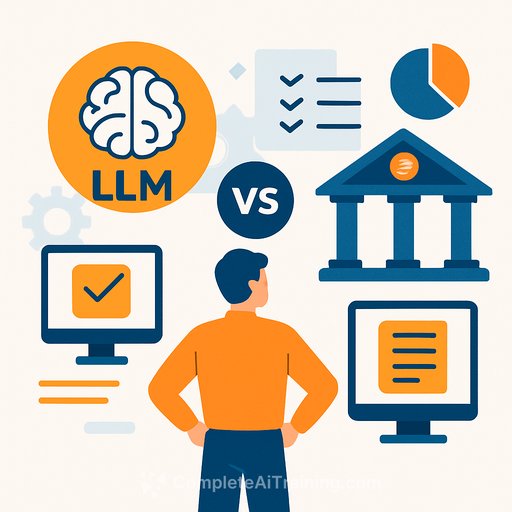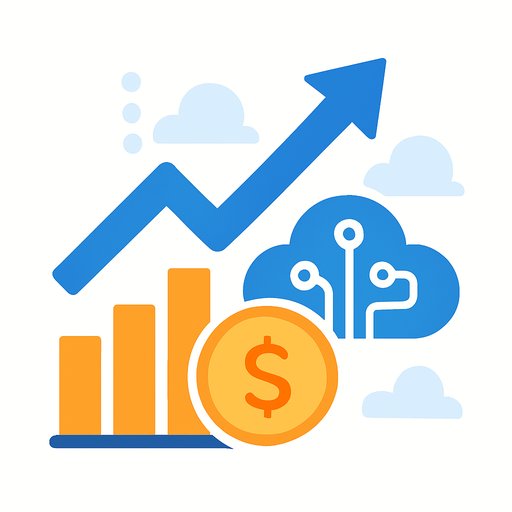Large Language Models (LLMs) vs. Small Language Models (SLMs) for Financial Institutions: A 2025 Practical Enterprise AI Guide
For banks, insurers, and asset managers in 2025, choosing between Large Language Models (LLMs) and Small Language Models (SLMs) depends on multiple factors like regulatory risk, data sensitivity, latency, cost, and use case complexity.
No single option fits all scenarios. SLMs, typically ranging from 1 to 15 billion parameters, are preferable for tasks like structured information extraction, customer service, coding help, and internal knowledge management—especially when combined with retrieval-augmented generation (RAG) and strong safety measures.
LLMs, often 30 billion parameters or more and accessed via APIs, are better suited for heavy synthesis, multi-step reasoning, or when smaller models can't meet performance or latency demands. Regardless of model size, governance and model risk management following standards like NIST AI RMF and the EU AI Act are essential.
1. Regulatory and Risk Posture
Financial services operate under strict model governance. In the US, Federal Reserve/OCC/FDIC's SR 11-7 requires validation, monitoring, and documentation for all models used in business decisions, including LLMs and SLMs.
The NIST AI Risk Management Framework (AI RMF 1.0) is widely adopted for AI risk controls. The EU AI Act enforces staged compliance: general-purpose models by August 2025, and high-risk systems like credit scoring by August 2026. High-risk applications require pre-market conformity, risk management, logging, and human oversight.
Sector-specific rules also apply:
- GLBA Safeguards Rule: Security controls and vendor oversight for consumer financial data.
- PCI DSS v4.0: Enhanced cardholder data controls mandatory from March 31, 2025.
Supervisors emphasize systemic risks like concentration, vendor lock-in, and model risk, regardless of model size. High-risk uses demand traceable validation, privacy assurance, and full compliance.
2. Capability vs. Cost, Latency, and Footprint
SLMs (3–15B parameters) deliver strong accuracy on domain-specific tasks after fine-tuning and with retrieval augmentation. Examples include Phi-3, FinBERT, and COiN, which excel at extraction, classification, workflow support, and operate with low latency (under 50ms). They also allow self-hosting, ensuring data residency and enabling edge deployment.
LLMs enable cross-document synthesis, reasoning across heterogeneous data, and handling long contexts (over 100,000 tokens). Domain-specialized LLMs like BloombergGPT (50B parameters) outperform general-purpose models on financial tasks and multi-step reasoning.
Transformer self-attention scales quadratically with sequence length. Optimizations like FlashAttention help but don’t eliminate this cost. Long-context LLMs can be exponentially more expensive at inference than short-context SLMs.
Key takeaway: Use SLMs for short, structured, latency-sensitive tasks such as contact centers, claims processing, and KYC extraction. Reserve LLMs for long-context synthesis or complex reasoning, managing costs via caching and selective escalation.
3. Security and Compliance Trade-offs
Both SLMs and LLMs face risks like prompt injection, insecure output handling, data leakage, and supply chain vulnerabilities.
- SLMs: Favor self-hosting, which aligns with GLBA, PCI, and data sovereignty rules and reduces legal risks from cross-border data transfers.
- LLMs: API use introduces vendor concentration and lock-in risks. Supervisors expect documented exit plans, fallback options, and multi-vendor strategies.
Explainability is critical for high-risk applications. Transparent features, challenger models, full decision logs, and human oversight are mandatory. LLM-generated reasoning does not replace formal validation required by regulations like SR 11-7 or the EU AI Act.
4. Deployment Patterns
Three effective approaches in finance include:
- SLM-first, LLM fallback: Route most queries to tuned SLMs with RAG. Escalate complex or low-confidence cases to LLMs. Suitable for call centers, operations, and document parsing.
- LLM-primary with tool-use: Use LLMs as orchestrators for synthesis, combined with deterministic tools for data access and calculations, secured with data loss prevention (DLP). Ideal for complex research and regulatory work.
- Domain-specialized LLM: Large models fine-tuned on financial corpora. Higher model risk management burden but can deliver gains for niche tasks.
Strong safeguards are essential: content filters, PII redaction, least-privilege access, output verification, red-teaming, and continuous monitoring following NIST AI RMF and OWASP guidelines.
5. Decision Matrix (Quick Reference)
| Criterion | Prefer SLM | Prefer LLM |
|---|---|---|
| Regulatory exposure | Internal assist, non-decisioning | High-risk use (credit scoring) with full validation |
| Data sensitivity | On-prem/VPC, PCI/GLBA constraints | External API with DLP, encryption, DPAs |
| Latency & cost | Sub-second, high QPS, cost-sensitive | Seconds-latency, batch, low QPS |
| Complexity | Extraction, routing, RAG-aided draft | Synthesis, ambiguous input, long-form context |
| Engineering ops | Self-hosted, CUDA, integration | Managed API, vendor risk, rapid deployment |
6. Concrete Use-Cases
- Customer Service: SLM-first with RAG and tools for common inquiries; escalate to LLMs for complex multi-policy questions.
- KYC/AML & Adverse Media: SLMs handle extraction and normalization; LLMs assist in fraud detection and multilingual synthesis.
- Credit Underwriting: High-risk under the EU AI Act. Use SLMs or classical ML for decisions; LLMs generate explanatory narratives with mandatory human review.
- Research/Portfolio Notes: LLMs help draft synthesis and collate cross-source information. Use read-only access, citation logging, and tool verification.
- Developer Productivity: On-prem SLM code assistants improve speed and protect IP; escalate to LLMs for complex refactoring or synthesis.
7. Performance and Cost Levers Before “Going Bigger”
- RAG optimization: Most failures stem from retrieval issues. Improve chunking, recency, and relevance ranking before increasing model size.
- Prompt and I/O controls: Implement input/output schema guardrails and anti-prompt-injection measures per OWASP.
- Serve-time optimizations: Quantize SLMs, use key-value caches, batch or stream requests, and cache frequent answers to reduce compute.
- Selective escalation: Route queries by confidence level to save over 70% in costs.
- Domain adaptation: Lightweight tuning and LoRA on SLMs close most performance gaps. Reserve large models for clear, measurable benefits.
Examples
Contract Intelligence at JPMorgan (COiN)
JPMorgan Chase implemented a specialized Small Language Model called COiN to automate commercial loan agreement reviews. Previously manual and time-consuming, this process was reduced from weeks to hours. COiN was trained on thousands of legal documents and regulatory filings, delivering high accuracy and compliance traceability. This allowed legal teams to focus on complex judgment tasks while cutting operational costs.
FinBERT
FinBERT is a transformer-based model trained on financial data such as earnings call transcripts, news articles, and market reports. It detects sentiment—positive, negative, or neutral—with high precision, capturing subtle tones that influence market behavior.
Financial institutions use FinBERT to assess sentiment around companies and market events, supporting forecasting and portfolio management. Its targeted financial training makes it more accurate than generic models for sentiment analysis, providing actionable insights for investors and analysts.
Your membership also unlocks:






